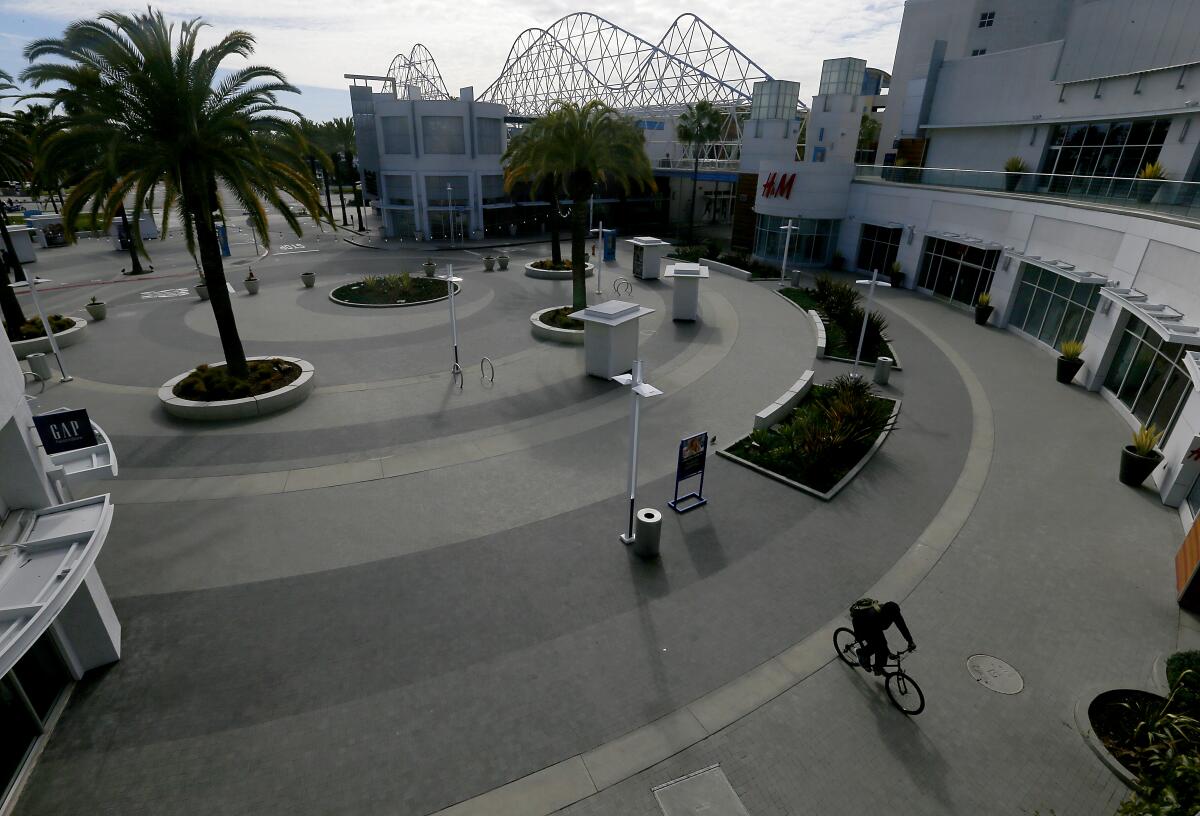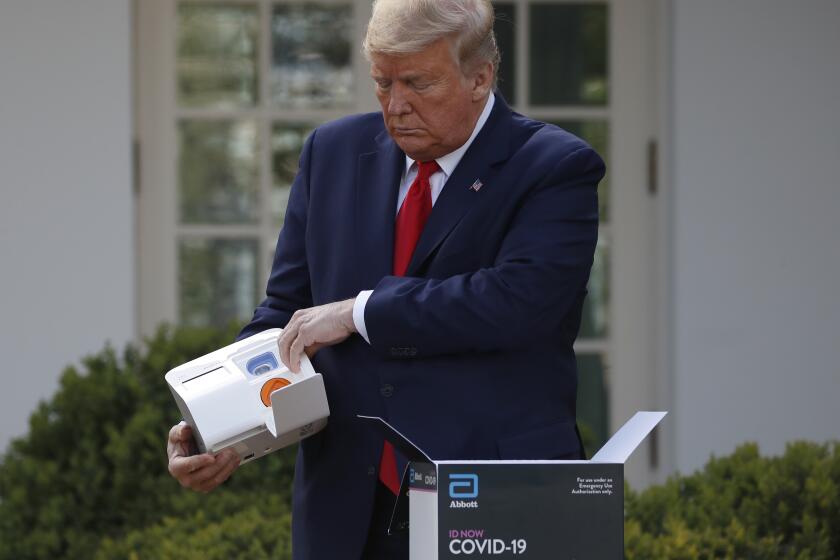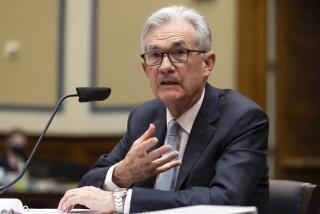Coronavirus recession now expected to be deeper and longer

- Share via
WASHINGTON — As projections of the coronavirus death toll soar, forecasts for the ensuing economic carnage have also quickly turned much darker — both for the depth and duration of the damage.
Where only days ago, economists were following President Trump’s lead in saying the U.S. economy would be back on track relatively quickly, a growing number now say the downturn will probably exceed the Great Recession of 2008-09.
U.S. economic output, which has grown without interruption for a record 10½ years, could fall as much as 9% in 2020 — more than three times the sharpest drop during the Great Recession, according to some predictions. At the height of the Great Depression in 1932, the economy shrank a record 12.9%.
These are some of the unusual new scenes across the Southland during the coronavirus outbreak.
“This is the dilemma of the disease and of the economy. To limit and control the disease you basically have to kill the economy. It’s a trade-off,” said Nariman Behravesh, chief economist at IHS Markit. The research firm doesn’t see an economic return to pre-pandemic levels for two to three years.
Janet Yellen, a former chairwoman of the Federal Reserve and now a distinguished fellow at the Brookings Institution, echoed the growing skepticism over what Trump and others have said would be a quick economic rebound once the virus subsides.
Pointing to how long it took to recover from past crises, she said it’s common for economic growth to remain on a lower track for years, not months.
“If firms are really damaged and cut back their investment spending on R&D dramatically, or workers become deskilled or lose productive connections to firms, those things can have long-lasting effects,” Yellen said during an online conference this week.
Global supply chains, which when they were functioning well had raised productivity and profits for many companies, are now facing significant disruptions, and there is a broad reconsideration of these economic linkages that could further slow growth, she said.
The current Fed leader, Jerome H. Powell, acknowledged the grim outlook while trying to remain optimistic about a relatively quick recovery.
“You may well see significant rises in unemployment and significant declines in economic activity, but there can also be a good rebound on the other side of that,” he said in a rare television appearance last week.
“It will really depend on the spread of the virus. The virus is going to dictate the timetable here,” he said.
Powell’s remark about the coronavirus calling the shots reflects a new awareness in Washington and beyond that the medical threat is far more serious than many originally suggested and that comparing COVID-19 to seasonal flu was dangerously misleading.
Within that scientific reality, medical experts and economists agree that the best hope for the least and shortest damage is a painful but tight adherence to the strategy of social distancing. That is, choking back physical contact between individuals and groups — using lockdowns and the mandatory closing of restaurants, bars, sports and entertainment venues and other places where more than a handful of people come together at one time.
The economic effects of social distancing — and the far greater potential cost of not embracing it — are reflected in the increasingly dark economic forecasts.
In the absence of a nationwide distribution plan, many smaller hospitals, nursing homes and physicians who need medical equipment are being left behind.
Several dozen prominent economists across the ideological spectrum, in a poll by the University of Chicago, were virtually unanimous in agreeing that there will be greater economic damage if lockdowns were abandoned while “the likelihood of a resurgence in infections remains high.”
The American economy, as measured by real gross domestic product, grew at a 2.3% rate last year — a moderate but still impressive pace given the much slower performance in other advanced nations.
That upbeat performance has almost certainly ended already, though official numbers are just beginning to be reported.
IHS Markit’s Behravesh foresees a U.S. contraction of 5.4% this year. Just a month earlier, in February, IHS had forecast an expansion of 2% for the year. Nomura Securities has an even grimmer outlook: a 9% decline in U.S. output.
That’s because except for government spending, every major category of economic activity is expected to fall off sharply, including business investments, trade and especially consumer spending for services.
In recent days only a couple of hundred thousand daily air travelers have been moving through security checkpoints, compared with 3.6 million a year ago, said Mark Zandi of Moody’s Analytics, citing government statistics. Open Table, the restaurant reservation system, is seeing practically zero bookings at restaurants in big cities such as Los Angeles, Chicago and New York, he noted.
Business closures have led to an unprecedented burst of layoffs. Jobless benefit claims during the week that ended March 21 soared to more than 3.2 million, five times the previous record high — and millions more filed for unemployment benefits last week.
Economists expect the nation’s jobless rate, which most recently had been at a half-century low of 3.5%, to surge in coming months. Goldman Sachs expects unemployment to soar to 15% by midyear.
How quickly might the economy get back on its feet from the tremendous body blows?
The U.S. can’t expect the kind of fast return seen in South Korea, which moved much faster and more decisively to do massive testing in February and targeted groups shutting down the economy.
Americans have also lost valuable time in embracing the draconian quarantine and lockdown measures of Singapore or China in Hubei province, where the pandemic began and which now — after two months of lockdowns and travel bans — is beginning to stir back to life.
One detailed forecast that was less bleak than some came from an analysis by Zandi and his team at Moody’s Analytics, which sees new COVID-19 infections peaking in May and abating significantly by July.
“If the virus and the medical response roughly follow this script, then businesses should be largely reopened by the third quarter of this year, resulting in a double-digit bounce in real GDP growth,” with about half of those losing their jobs quickly returning to work, Zandi wrote.
But then it’ll get tougher: “Even though the virus will have receded, an economic slog will continue with weak job growth and persistently high unemployment as worries that the virus will flare up again stymie travel, trade and business expansion,” he said.
Significant uncertainties may restrain business spending, with energy investments in particular tanking along with crude oil prices, as well as lead to a protracted increase in unemployment.
“When uncertainty rises, employers may choose to wait and see before filling new positions, contributing to higher unemployment,” economists at the San Francisco Fed said.
Consumers, whose spending accounts for 70% of economic activity, may also hesitate for months before returning to pre-pandemic activity and spending habits. After the 9/11 terrorist attacks, Behravesh said, it took 2½ years for airline traffic to come to previous levels.
Consumer confidence already has started to erode, by some measures falling deeper than after 9/11 and the Great Recession. And experts expect that many investors and households will choose to sock away money to rebuild savings and retirement nest eggs.
Even as Goldman Sachs marked down U.S. output to fall by a whopping 34% at an annual rate in the current quarter, the investment banking firm raised its forecast for the third quarter largely because of aggressive action by the Fed and the federal government.
The fast and strong response with monetary and fiscal stimulus in the United States and elsewhere could limit the damage and help many businesses and households avoid bankruptcies, enabling them to recover more quickly once the economy reopens.
The $2-trillion coronavirus relief package that Trump signed into law Friday will provide direct payments of $1,200 to many individual taxpayers and vastly expands unemployment insurance benefits for jobless workers and those whose hours have been cut.
What’s more, the aid package sets aside about $350 billion for loans to small employers that could be converted to grants if they hold on to their workforce, and billions more to support loans to big companies, including hard-hit airlines, that are conditioned on maintaining certain payroll levels.
How quickly all that financial aid can be delivered, and how long it will remain sufficient, are questions most economists have barely begun to consider.
More to Read
Get the L.A. Times Politics newsletter
Deeply reported insights into legislation, politics and policy from Sacramento, Washington and beyond. In your inbox twice per week.
You may occasionally receive promotional content from the Los Angeles Times.













